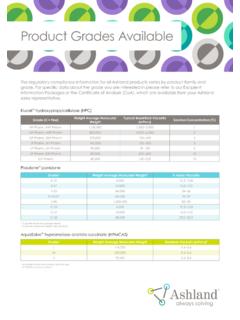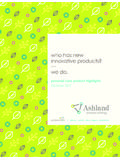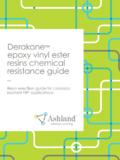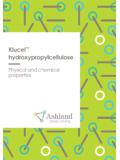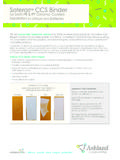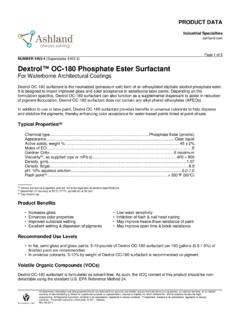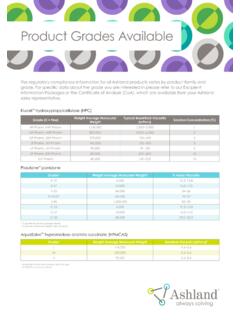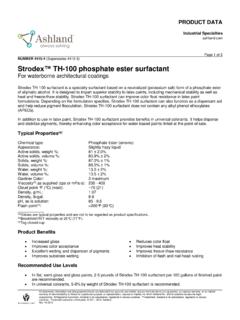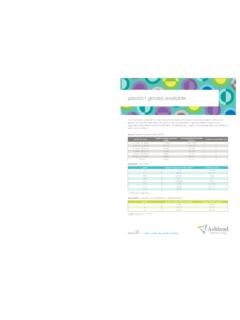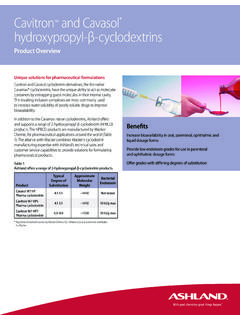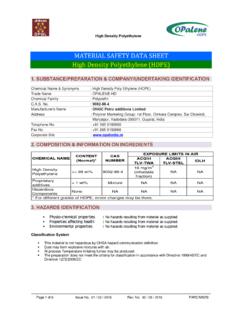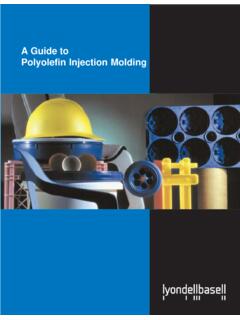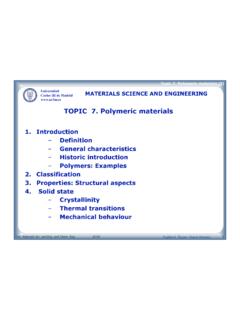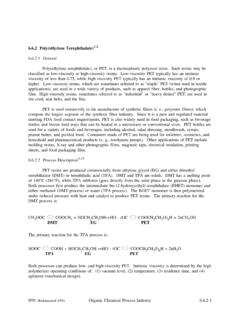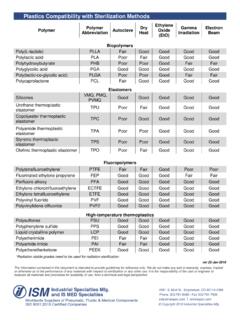Transcription of formulating elegant liquid and semisolid drug products
1 formulating elegant liquid and semisolid drug products natrosol 250 hydroxyethylcellulose (HEC) 2contentsintroduction ..3polymer chemistry ..4grades and specifications ..5products available ..5pharmacopeial specifications ..6polymer properties ..7typical properties ..7solubility in water and organic solvents ..7moisture absorption ..8dissolving natrosol 250 pharm HEC in water ..9microbial limits ..10properties of solutions and gels of natrosol 250 pharm HEC ..11viscosity ..11effect of concentration ..11effect of shear rate ..11effects of of pH ..15mechanical properties of natrosol 250 pharm HEC gels ..16antimicrobial preservatives ..17heat sterilization and sterile filtration ..17heat sterilization ..17sterile filtration.
2 17synergistic effect with sodium carboxymethylcellulose ..18tolerance for inorganic salts ..19compatibility with other materials ..20application examples for natrosol 250 pharm HEC ..21natrosol 250 pharm HEC as a viscosity modifier in pharmaceutical oral liquids ..21case study: sugar-free ambroxol syrup ..22case study: taste-masked loratadine syrup ..23case study: syrup for poorly soluble paracetamol ..24natrosol 250 pharm HEC as rheology modifier and structured vehicle promoter for semi-solid formulations ..25case study: diclofenac gel ..26case study: aluminum hydroxide oral gel ..27ophthalmic solutions using natrosol 250 pharm HEC ..29packaging and storage ..31product safety and handling precautions ..31toxicological studies.
3 31introductionNatrosol 250 Pharm hydroxyethylcellulose (HEC) is a nonionic, water-soluble polymer widely used in pharmaceutical formulations. Like Aqualon and Blanose sodium carboxymethylcellulose (CMC), it is a cellulose ether, but it differs in that it is nonionic and its solutions are unaffected by cations and, thus, less affected by pH changes and more tolerant of the presence of anions and organic co-solvents. It also differs from other cellulose ethers, such as Klucel hydroxypropylcellulose (HPC) and Benecel hydroxypropylmethylcellulose (HPMC), in that it is soluble in both cold and hot water and does not precipitate from aqueous solutions at elevated brochure describes the properties of Natrosol 250 Pharm HEC and its solutions.
4 Natrosol 250 Pharm HEC is a versatile pharmaceutical excipient with many applications including as a tablet binder, a modified-release matrix former, a film-coating agent, and a viscosity modifier. In this brochure we describe the properties and applications of Natrosol 250 Pharm HEC in semi-solid and liquid pharmaceutical formulations. 4polymer chemistryThe Natrosol 250 Pharm HEC polymer is a partially substituted poly(hydroxyethyl) ether of cellulose. The base of the HEC molecule is formed by the polysaccharide cellulose and its (1 4) linked D-glucose units. The structure of the cellulose molecule can be visualized as a polymer chain composed of repeating cellobiose units. These, in turn, are composed of two anhydroglucose units ( -glucopyranose residues).
5 Each anhydroglucose unit contains three hydroxyls capable of reaction, shown in light blue in figure 1: Structure of cellulose in chair form 2: Idealized structure of Natrosol 250 Pharm HEC. This example has a MS of (10 ethylene oxide groups/4 anhydroglucose units) and a DS of (6 hydroxyls substituted/4 anhydroglucose units).OHOHOHOHOHOHOHOOOOOOOHOHOHOOHOHOH OH66n3322 The number of hydroxyl groups substituted per anhydroglucose unit in any reaction is known as the degree of substitution, or DS. Theoretically, all three hydroxyls can be substituted. If all three hydroxyls are replaced, the maximum theoretical of (impossible in practice) would result. By treating cellulose with sodium hydroxide and reacting with ethylene oxide, hydroxyethyl groups are introduced to yield a hydroxyethyl ether.
6 The reaction product is purified and ground to a white to light tan, free-flowing powder. Substitution can also occur when ethylene oxide reacts at previously substituted hydroxyls, and polymerizes to form a side chain (branching). The average number of moles of ethylene oxide that become attached to each anhydroglucose unit in cellulose, in the two ways described, are called total molar substitution, or reacting ethylene oxide with cellulose to form the hydroxyethyl ether of cellulose, solubility in water is achieved as the degree of substitution is increased. By selecting appropriate reaction conditions and moles of substituent, complete and quick solubility in water is obtained. Natrosol 250 Pharm HEC, which has optimum solubility in water, has a MS of An idealized structure of Natrosol 250 Pharm HEC is shown in figure 2.
7 This example has a MS of (10 ethylene oxide groups/4 anhydroglucose units) and a DS of (6 hydroxyls substituted/4 anhydroglucose units).OHOHOHOHOHOHOHOOOOOOOOOOOOOOOOOHO HOHOHOHOHOOH66n3322grades and specificationsproducts availableNatrosol 250 Pharm hydroxyethyl cellulose (HEC) is available in several grades as given in table 1. The available grades differ principally in their weight average molecular weight, and thus, in their viscosities table 1: Different grades of Natrosol 250 Pharm HEC grades. (X = fine grade and W = superfine grade).Brookfield viscosity*gradeweight average molecular weight (Da)Brookfield LVF viscosity at 25 C, mPa ssolution concentrationEP viscosity label** at 10s 1 and 25 C (mPa s in 2% solution)natrosol 250 L pharm90,00075 15 05% (at 100s 1)natrosol 250 G pharm300,000250 4002%295natrosol 250 M pharm720,0004,500 6,5002%4,400natrosol 250 H pharm1,000,0001,500 2,5001%8,500natrosol 250 HX pharm1,000,0001,500 2,5001%8,500natrosol 250 HHX pharm1,300,0003,500 5,5001%14,5 0 0natrosol 250 HHW pharm1,300,0003,500 5,5001%14,5 0 0* Brookfield LV viscosity at 25 C, mPa s, according to the Ashland method**EP label viscosity based on the EP viscosity method.
8 EP viscosity range 75 140% of the value stated on the label (NF viscosity range 50 150% of the value stated on the label).measured in aqueous solutions. Additionally, different particle sizes are available to optimize the performance in specific applications, such as the use as matrix former for modified release tablets Natrosol 250 Pharm HEC uses a maximum of 1% phosphates as a pH stabilizer. 6pharmacopeial specifications*Low molecular weight HEC with an apparent viscosity of 1000 mPa s (2% w/v) or 2: Pharmacopeial specifications for hydroxyethylcellulose and compendial compliance of Natrosol 250 Pharm Eur. specificationresidue on ignition (calculated as Na2SO4, %) natrosol 250 G pharm and natrosol 250 L pharm* max all other max maxpH, 1% on drying, % maxnitrate, % natrosol 250 G pharm and natrosol 250 L pharm* max max all other max maxchlorides, % max maxheavy metals (as lead), ppm 20 max20 max10 maxlead, ppm 10 maxarsenic, ppm 3 maxglyoxal, ppm20 max 20 maxethylene oxide, ppm1 max 1 max2-chloroethanol, ppm10 max 10 maxExcipient grades of Natrosol 250 Pharm HEC meet the monograph requirements as set forth in the current editions of the United States National Formulary (NF) and the European Pharmacopoeia (Ph.)
9 Eur.) The pharmacopeial specifications and Ashland s product specifications are listed in table 2. For pH stabilization of Natrosol 250 Pharm HEC a certain amount of phosphate is added. Added phosphate quantity is printed on the bag 250 HEC Pharm grades meet the monograph requirements of the United States National Formulary (NF) and the European Pharmacopoeia (Ph. Eur.).polymer propertiestypical propertiestable 3: Typical properties for Natrosol 250 Pharm hydroxyethylcellulose. propertyvalueacidity/alkalinitypH for a 1% w/v aqueous solutiondensity (bulk) g/cm density (tap) g/cm moisture content 5% (w/w) of waterparticle size distributionstandard grind, retained on #40 mesh (420 m; max 10%)X-grind, retained on #60 mesh (250 m; max )type HHW, retained on #80 mesh (177 m; max )table 4: Surface tension of different Natrosol 250 Pharm HEC grades at varying concentrations and tension (dyne/cm or mN/m) 01% (w/v) (w/v) (w/v) solutiongradeat 20 Cat 25 Cat 20 Cat 25 Cat 20 Cat 25 Cnatrosol 250 L pharm 7.
10 250 G pharm HEC69. 7. 250 M pharm HEC69. 769. 7. 250 H pharm HEC6 7. 250 HX pharm HEC6 7. 250 HHX pharm HEC6 7. 7. in water and organic solventsNatrosol 250 Pharm HEC dissolves quickly in cold or hot water to form clear and smooth solutions; furthermore, it does not gel or precipitate even when heated to the boiling point of water. Natrosol 250 Pharm HEC is essentially insoluble in organic solvents. It is, however, partly soluble in some solvents, usually those that are miscible with water ( , ethanol: water mixtures), or that contain polar groups ( , glycerin and propylene glycol at temperatures around 55 C to 60 C). The most important uses of Natrosol 250 Pharm HEC involve its aqueous solutions it is soluble in both hot and cold water.
